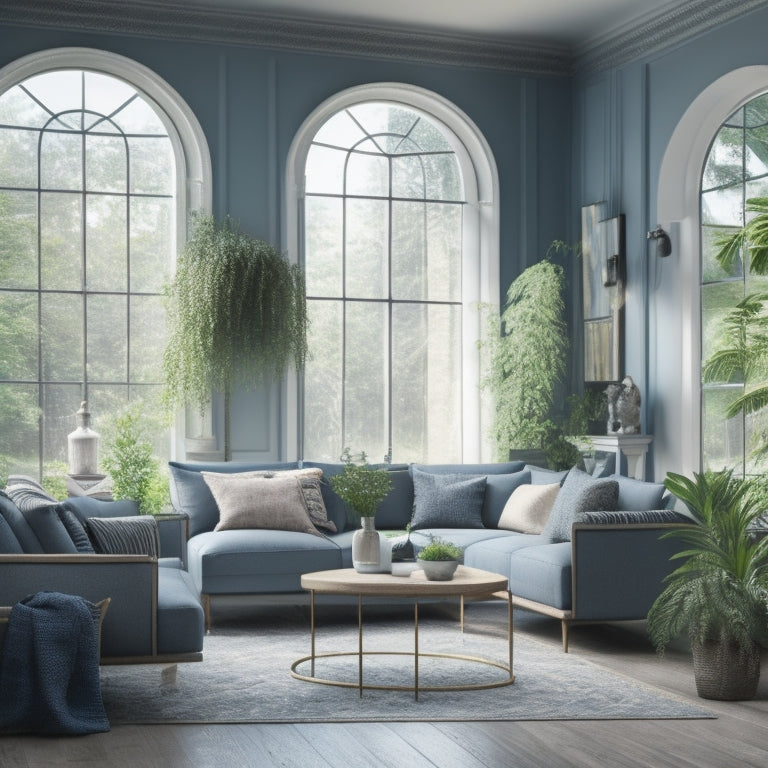
Quiet Comfort: Top Noise-Reducing Energy-Saving Window Choices
Share
You're seeking quiet comfort in your living or working space, and the right window choice can make all the difference. Double-glazed and triple-glazed windows are highly effective in minimizing external noise disturbance, and incorporating renewable energy solutions enhances sustainability. Acoustic glass options, such as laminated and insulated glass units, absorb sound waves, while energy-efficient window frames minimize air leakage and heat transfer, contributing to noise reduction. Uncover how window frame materials, insulation, and design innovations work together to create a quieter living environment, and investigate the various standards and certifications that guarantee peak noise reduction and energy efficiency in your window choices, leading you to a more peaceful and comfortable space.
Key Takeaways
- Double-glazed and triple-glazed windows minimize external noise disturbance by acting as a noise barrier, with proper installation crucial for optimal performance.
- Acoustic glass options like laminated and insulated glass units absorb sound waves, reducing outside noise through layered design and airspaces.
- Energy-efficient window frames with advanced insulation materials and thermal break technology contribute to quieter living environments by reducing air leakage and heat transfer.
- Window design innovations like thermal breaks, multi-chambered frames, and narrow frame profiles enhance insulation and minimize sound transmission through the frame.
- Acoustic coatings like acoustic, low-E, ceramic, and nano-coatings can provide an additional 1-7 dB noise reduction, effectively absorbing sound waves.
Double-Glazed Window Solutions
When it comes to reducing noise pollution in your home or office, double-glazed window solutions offer a highly effective way to minimize external noise disturbance.
By installing these windows, you can considerably reduce the amount of outside noise that enters your space, creating a more peaceful environment.
In addition, incorporating renewable energy solutions into your building design can further enhance the overall sustainability of your space.
Double-glazed windows feature two panes of glass separated by a gap, which acts as a barrier to block out noise.
While they're highly effective, you may also want to take into account triple glazed options for even greater noise reduction.
Proper window installation is vital to guarantee the best performance of your double-glazed windows.
Sound-Absorbing Window Materials
You'll find that sound-absorbing window materials can greatly reduce noise pollution in your home.
Acoustic glass options, such as laminated or insulated glass units, can absorb sound waves, minimizing external noise.
Moreover, the environmental impact of electric vehicle production, including mining of precious metals electric car production's toll, is a concern that shouldn't be overlooked.
Additionally, the type of window frame materials you choose, including vinyl, aluminum, or wood, can also impact the overall sound-absorbing performance of your windows.
Acoustic Glass Options
Six types of acoustic glass options are available to effectively reduce noise pollution.
You'll find that each type offers unique benefits for sound insulation. Acoustic laminates, for instance, feature multiple layers of glass and interlayers that absorb sound energy. This results in a significant reduction of outside noise.
As companies endeavor for sustainable practices, incorporating acoustic glass options into their designs can contribute to a more environmentally friendly approach. Furthermore, understanding the costs associated with recycling hazardous materials, such as those found in solar panels and batteries, can help businesses make more informed decisions.
Other options include tempered acoustic glass, which combines strength with sound-dampening properties, and acoustic insulated glass units that use airspaces to further minimize noise transmission.
You can also consider acoustic coated glass, which features a specialized coating to reduce sound reflection. In addition, there's acoustic annealed glass, acoustic low-iron glass, and acoustic borosilicate glass, each with its own strengths in sound insulation.
Window Frame Materials
Beyond acoustic glass options, the window frame material plays an essential role in reducing noise pollution.
When selecting a window frame, you'll want to reflect on materials that excel in frame durability and aesthetic appeal.
In addition, commercial solar charging systems can lower operational costs and improve energy efficiency Energy Storage and Grid Resiliency, making them a significant factor for eco-friendly homeowners.
- Vinyl frames: Offer excellent noise reduction, low maintenance, and affordability.
- Fiberglass frames: Provide strength, durability, and resistance to warping or cracking.
- Aluminum frames: Combine strength, corrosion resistance, and a modern aesthetic.
- Wood frames: Offer a natural, traditional look and can be stained or painted to match your home's style.
Energy-Efficient Window Frames
Energy-efficient window frames play an important role in reducing noise pollution by minimizing air leakage and heat transfer. When you choose frames with ideal insulation, you'll experience a quieter living space.
Frame insulation is vital, as it prevents heat from escaping and reduces thermal bridging – the flow of heat through the frame. This, in turn, minimizes the energy required to heat or cool your home. By selecting frames with high insulation values, you'll enjoy a more comfortable living space while keeping energy costs low.
In addition, reducing reliance on fossil fuels and lowering carbon footprint, as seen in solar roofing systems, can also contribute to a quieter environment and enhance business reputation.
Look for frames with advanced insulation materials and thermal break technology to maximize energy efficiency. By doing so, you'll reap the benefits of a quieter, more energy-efficient home.
Acoustic Performance Standards
Most new windows meet some level of acoustic performance standard, which guarantees they can effectively reduce noise pollution.
When shopping for noise-reducing windows, you'll want to look for products that meet certain standards for acoustic insulation and sound transmission.
Here's what to look for:
-
Sound Transmission Class (STC): Measures a window's ability to reduce airborne sound transmission, such as traffic noise or voices.
-
Outdoor-Indoor Transmission Class (OITC): Evaluates a window's ability to reduce sound transmission from outdoor sources, like traffic or construction.
-
Noise Reduction Coefficient (NRC): Assesses a material's ability to absorb sound, rather than reflect it.
- Acoustic Insulation Rating: A product's overall ability to reduce sound transmission, usually measured in decibels (dB).
Low-E Glass Technology Benefits
You're likely familiar with the benefits of low-E glass technology, but let's take a closer look at how it can improve your window's performance.
By reducing heat transfer and minimizing energy loss, low-E glass gives you an energy efficiency enhancement, which can lead to significant cost savings over time.
Additionally, low-E glass also blocks UV rays, protecting your furniture and carpets from fading and discoloration.
Energy Efficiency Boost
About 90% of a window's heat transfer occurs through the glass, making it an essential component in energy efficiency.
Low-E glass technology is a breakthrough in this regard. By incorporating a thin metal or metal oxide coating, you can greatly reduce heat transfer, resulting in improved thermal performance and cost savings.
Here are four key benefits you'll enjoy with Low-E glass:
-
Reduced heat loss: Minimize the amount of heat that escapes through your windows during the winter.
-
Less heat gain: Keep your home cooler in the summer by reducing the amount of heat that enters through your windows.
-
Lower energy bills: With reduced heat transfer, you'll see a decrease in your energy costs.
- Increased comfort: Enjoy a more consistent and comfortable temperature in your home, no matter the season.
UV Ray Blockage
By reducing heat transfer, Low-E glass technology also blocks a significant amount of ultraviolet (UV) radiation from entering your home.
This means you'll enjoy improved UV protection benefits, keeping your furniture, carpets, and curtains from fading. You'll also reduce the risk of skin damage and skin cancer.
With Low-E glass, you can choose from various window tinting options to suit your style and preferences. You can opt for a subtle, almost imperceptible tint or a more pronounced one, depending on your needs.
Either way, you'll reap the rewards of reduced UV radiation and a more comfortable living space.
Insulated Window Frame Designs
Insulated window frame designs have emerged as an essential factor in noise reduction, thanks to their ability to minimize air leakage and reduce sound transmission.
When you're looking for a quiet and peaceful living space, you'll want to take into account frames that excel in this regard.
To achieve the best noise reduction, look for frames that incorporate the following design innovations:
- Thermal breaks: These separate the inner and outer frames, reducing heat transfer and noise conduction.
- Multi-chambered frames: These add insulation and reduce sound transmission through the frame itself.
- Narrow frame profiles: These minimize the visible frame area, reducing noise leakage.
- Frame aesthetics with integrated seals: These guarantee a tight seal between the frame and the surrounding wall, preventing air leakage and noise entry.
Noise Reduction Coatings Explained
In addition to advanced frame designs, another critical component of noise-reducing windows lies in specialized coatings that can greatly minimize external noise penetration. These coatings can considerably reduce external noise pollution, allowing you to enjoy a more peaceful living space.
| Coating Type | Noise Reduction | Description |
|---|---|---|
| Acoustic | 3-5 dB | A soft, flexible coating that absorbs sound waves |
| Low-E | 2-3 dB | A thin, metallic coating that reduces heat transfer and noise |
| Ceramic | 4-6 dB | A durable, ceramic-based coating that provides excellent noise reduction |
| Polymer | 1-2 dB | A flexible, polymer-based coating that reduces noise and improves window durability |
| Nano-Coating | 5-7 dB | An advanced, nanotechnology-based coating that provides exceptional noise reduction |
Sustainable Window Manufacturing
As you investigate the various components of noise-reducing windows, you'll find that sustainable manufacturing processes play an essential role in their overall eco-friendliness.
Eco-friendly manufacturing isn't just a buzzword; it's a critical aspect of reducing a window's carbon footprint. You'll want to look for manufacturers that incorporate sustainable practices into every stage of production.
Here are some key indicators of sustainable window manufacturing:
-
Use of recycled materials: Windows made with recycled materials reduce waste and conserve natural resources.
-
Ethical sourcing: Confirm that manufacturers source materials from environmentally responsible suppliers.
-
Resource efficiency: Look for manufacturers that optimize their production processes to minimize waste and reduce energy consumption.
- Green certifications: Check for certifications like ENERGY STAR or Cradle to Cradle, which verify a manufacturer's commitment to sustainability.
Energy Star Window Ratings
You'll want to look for windows with Energy Star certification, which indicates that they meet energy efficiency standards set by the U.S. Environmental Protection Agency.
These windows are designed to reduce heat transfer, minimizing the energy needed to heat and cool your home.
Energy Star Certification
With energy efficiency becoming a top priority in modern construction, Energy Star certification has emerged as a benchmark for windows that meet rigorous energy-saving standards.
As you consider energy-efficient windows, understanding the certification process is vital. You want to guarantee that your windows meet the standards set by the U.S. Environmental Protection Agency (EPA).
Here's what you need to know:
-
Energy Savings: Energy Star certified windows are designed to reduce heat transfer, minimizing energy losses and keeping your home comfortable while reducing energy bills.
-
Certification Process: Windows are tested and certified by the EPA based on their energy performance, confirming they meet strict energy efficiency guidelines.
-
Regional Climate Zones: Energy Star certified windows are categorized into four climate zones, ensuring that the windows you choose are suitable for your region's climate.
- Labeling and Verification: Look for the Energy Star label on windows, which indicates that they've been certified and verified to meet energy efficiency standards.
Window Energy Efficiency
Energy efficiency ratings, a crucial aspect of Energy Star certification, provide a clear depiction of a window's performance.
You'll want to take into account factors like U-factor, solar heat gain coefficient, and air leakage to determine how well a window insulates and reduces heat transfer.
Thermal bridging, which occurs when materials with high thermal conductivity come into contact, can greatly impact a window's energy efficiency.
When conducting energy audits, look for windows with low U-factors (around 0.30 or less) and air leakage ratings of 0.3 or less.
Additionally, think about windows with spectrally selective coatings that minimize heat gain during summer and heat loss during winter.
Window Soundproofing Techniques
Implementing effective window soundproofing techniques is essential to minimizing noise pollution in your home or office.
You can considerably reduce external noise and create a more peaceful environment by employing the right soundproofing methods.
When it comes to window treatments, consider the following options:
-
Acoustic window inserts: These are clear panels that can be installed into your existing windows to reduce noise.
-
Soundproofing curtains: Thick, heavy curtains can help absorb sound waves, minimizing external noise.
-
Window plugs: These are removable inserts that can be placed into your window frames to block sound.
- Replacement windows: If you're in the process of replacing your windows, look for ones with soundproofing features, such as double- or triple-glazed glass.
Frequently Asked Questions
Can I Install Noise-Reducing Windows in My Existing Window Frames?
You're "cut from the same cloth" as many homeowners seeking to reduce noise pollution - and the answer is yes, you can install noise-reducing windows in your existing window frames, but compatibility and installation methods are key to a seamless process.
Are Acoustic Windows More Expensive Than Standard Windows?
You'll find that acoustic windows typically cost more than standard ones, but their benefits, like reduced noise and improved energy efficiency, often outweigh the extra expense, making them a worthwhile investment for your peace of mind.
Do Energy-Efficient Windows Reduce Outside Noise Pollution?
You'll find that energy-efficient windows indeed reduce outside noise pollution; in fact, studies show that advanced window materials, like triple-glazed glass and acoustic frames, can minimize noise reduction by up to 90%, giving you peaceful freedom.
Can I DIY Install Noise-Reducing Window Inserts?
You can DIY install noise-reducing window inserts, leveraging benefits like reduced noise pollution and increased energy efficiency. Follow manufacturer instructions, ensuring a precise fit to maximize insert benefits and minimize gaps for ideal performance.
Are Soundproof Windows Suitable for Homes Near Airports?
You're wondering if soundproof windows can help you escape airport noise. Yes, advanced window technology is designed to reduce noise pollution, making it an ideal solution for homes near airports, providing you with a quieter, more peaceful living space.
Related Posts
-

7 Best Home Hydrogen Fuel Cells for Clean Power
You're considering adopting hydrogen fuel cells for clean power at home, but you want to know the best options. Reput...
-

What Roofing Materials Best Protect Our Planet?
As you consider the environmental impact of your building, you're likely to find that the roofing material you choose...
-

10 Best Sustainable Waste Management Solutions for Green Homes
You're likely unaware that the average green home generates over 2 kilograms of waste daily, but with the right susta...


